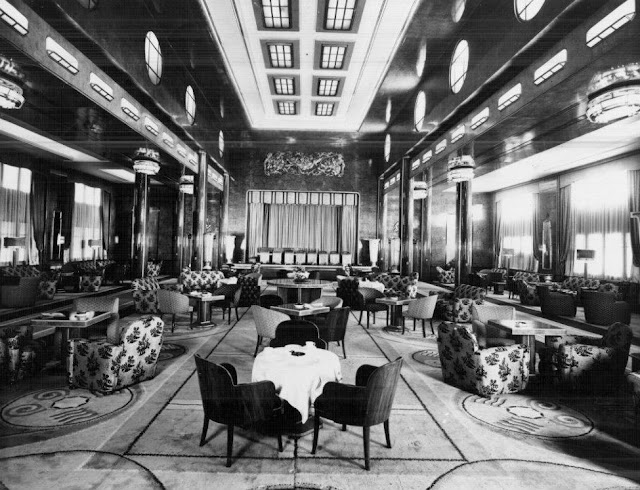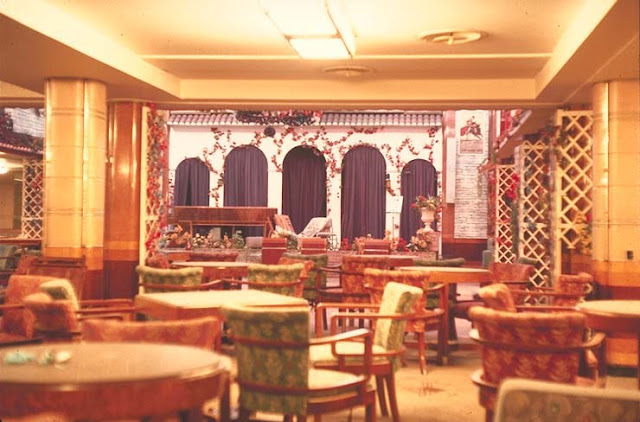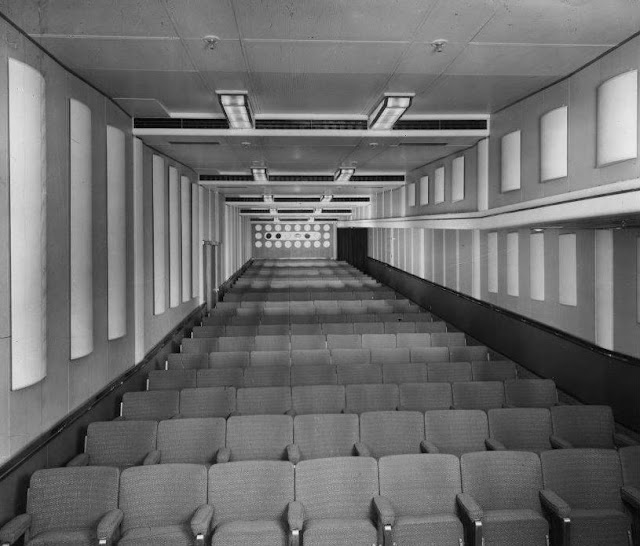1126 Queens Highway Long Beach, CA 90802 | map |
The RMS Queen Mary was built for the Cunard-White Star line by John Brown & Company in Clydebank, Scotland. The launch was September 26, 1934 and the maiden voyage began May 27, 1936. The ship was retired in 1967. It's owned by the City of Long Beach and is currently closed.
The Queen's Salon:
A vintage view of the Main Lounge, later renamed the Queen's Salon. The photo is from the Queen Mary Archives. This was a multipurpose area on the Promenade Deck that also served as the original cinema for First Class passengers. Many thanks to Anna Rojas and Commodore Everette Hoard, formerly of the Queen Mary staff, for generously sharing information and vintage photos from the ship's archives.
The Salon is in in the middle of the ship on the Promenade Deck. As a banquet area it can seat 250. It's now used for concerts, films and dining. Susan Kim, in an article for the National Trust magazine "Preservation" described the room:
"Elite passengers mingled in the cavernous First Class Main Lounge (later named the Queen’s Salon). With tall ceilings, three decks high, the salon boasts etched-glass panels, gold onyx urns, a massive relief by sculptor Maurice Lambert, and a gilded gesso panel—all prime examples of 1930s design. In the liner’s heyday, Fred Astaire cut a rug on this dance floor."
Cristopher Crouch, on a Cinelog post "Golden Era Cinema at Sea," noted: "At the time of the ship’s launch, the movie theatre was promoted as being 'talkie' equipped and featuring a 'giant screen' for the 'leisurely pleasure' of first class passengers."
This room in the movies: It has been a popular film location, appearing in "The Godfather: Part II" (Paramount, 1974), "The Natural" (TriStar, 1984) and "The Aviator" (Miramax/Warner Bros., 2004).
Desi and Lucy: Javier Bardem takes Nicole Kidman out to an unnamed L.A.
nightclub on a early date to teach her how to do the rumba in Aaron Sorkin's "Being the Ricardos" (Amazon, 2021). Later the Salon doubles as Ciro's, where Desi has a gig with his band. The
film also features J.K. Simmons, Nina Arianda, Tony Hale, Alia Shawkat,
Jake Lacy, Linda Lavin, Ronny Cox and Clark Gregg. The cinematography
was by Jeff Cronenweth. See the Historic L.A. Theatres in Movies post for a Ciro's shot plus a view outside the Palace, doubling as the back door of Ciro's.
Status: The Queen's Salon is as elegant as ever and, until the pandemic closing as well as operator financial issues surfaced, it hosted parties, films and special events.
Looking toward the screen end of the space from off to the side. This vintage view is from the Queen Mary Archives.
A look toward the unicorn mural on the back wall. Note the projection ports half way up. The staff is doing a bit of cleaning in this undated photo from the Queen Mary Archives.
A vintage view of the booth. Fitted with, of course, British equipment. Note the Gaumont Kalee projectors and the Gaumont arc lamps. The photo is from the Queen Mary Archives.
The back side of machine #1. The photo is from the Queen Mary Archives. The booth no longer has any permanently installed film equipment.
A look out one of the ports. Thanks to Joe E. Bee for adding his photo as a comment to a post about the room on the
R.M.S. Queen Mary Memorabilia Facebook page.
A look at the Queen's Salon that had appeared on a now-vanished Queen Mary website.
A view from off to the side. Thanks to Ian McIver for the photo.
A more recent view back toward the unicorn mural. It's a photo from the site
Deco Weddings.
A detail of the mural. Thanks to Ian McIver for the photo.
The Second Class Lounge:
This room was used until 1939 as the cinema for the Second Class patrons, a category called Tourist Class pre-war and Cabin Class following 1947. The 1936 Stewart Bale photo appears on the fine "
Second Class Main Lounge" page of the site The Queen Mary, where they offer this description:
"The second class main lounge – as designed and seen in original 1936 Stewart Bale photographs, was one of the smartest and most contemporary interiors on the Queen Mary. Located on M deck just aft of the second class grand staircase, (and across the broad crosswalk from the second class library and writing room, cocktail lounge and children's playroom), it was not simply a pared down version of the first class lounge, but had a gaiety and style all of its own. The high style and elegance of the appointments were the result of Cunard White Star's decision to make second class accommodations on the Queen Mary better than those on all competing ships on the North Atlantic -- including the fabled S.S. Normandie."
The room had a capacity of 388 when set up as a cinema. The site The Queen Mary reproduces details about the space from the publication Shipbuilder:
"The arrangements for entertainment are on a scale never previously attempted [in second class]. The room is of imposing proportions, the length being 80ft., the width 70ft., and the centre space over the dancing floor 16ft. in height. The dance floor, in parquet, measures 33ft. long by 28ft. wide. The floor treatment consists of a large centrepiece, in which lines of oak and walnut radiate from octagonal oak panels to form a composite pattern covering the whole area. The stage at the after end is 20ft. long with a depth of 8ft. from front to rear, and a proscenium 27ft. wide by 16ft. high. The curtains of the stage are in silver and green.
"A large cinema screen and the latest sound-film equipment are provided. When arranged as a cinema, the lounge has accommodation for an audience of 388 persons, while in normal use there is seating capacity for 210. A full equipment of colour-changing effects, spotlights and footlights are incorporated in the theatre lighting system, and the decorative effects are greatly enhanced by the use of beautiful silver and wax flowers ornamenting the stage. Jardinieres with fresh flowers are arranged in front of the stage. The general lighting of the room is from concealed cornice fittings over the dance floor, and from ceiling fittings at the sides.
"A most charming colour combination in green, ivory and silver is achieved in applique leather for all the upper wall surfaces above a dado of selected Thuya burr, figured birch and maple, with a skirting in black rubber. A horizontal striped design gives the walls a touch of gaiety, which balances the more serious and practical leather furniture with which [the occasional furniture in] the salon is equipped. Additional ornament is supplied by the delightful decorative motifs painted on the hide by Miss Margot Gilbert, illustrating dancing through the ages, while there is a pleasing etched-niche mirror in green glass … to the design of the same artist.
"There are 28 windows in the room, all framed in silver-bronze metal. The floor is entirely covered with thick Wilton carpets, laid over 3/8in. cork supplied by the Korkoid Company, while a large rug is provided for the dance floor when not in use for that purpose. The furniture in amboyna and Macassar ebony, and upholstered in green, cream and black materials, includes a wide range of easy chairs and settees, card and periodical tables, and fitted writing tables, arranged in recesses. A special type of cinema chair, designed both for comfort and easy stacking, is provided when the room is being employed for this purpose. The decorative contract for the tourist-class main lounge as well as the library and writing room, was carried out by Messrs. Trollope & Sons, of London."
Another 1936 view of the room. It's a Stewart Bale photo appearing on the "
Second Class Main Lounge" page of the site The Queen Mary. The room was restored in the 1947 retrofit but then no longer used as a cinema.
Later when the liner was used as a single-class cruise ship this area was redone with a Spanish motif and called "The Flamenco Room" to distinguish it from the First Class Lounge. It's another photo from the "
Second Class Main Lounge" page on the site The Queen Mary.
Status: After arriving in Long Beach, this area was restored to a deco look and, until the 2020 closing, was a banqueting area known as the Brittania Salon.
The First Class Cinema, post-1947:
Following a 1947 retrofit to refurbish what had been used as a troopship
during World War II, this new theatre, called the First Class Cinema, was created out of what had been the
Starboard Gallery. This theatre served both First and
Second Class passengers. The image comes from a postcard on the site
Card Cow. It can also be seen on Christopher Crouch's post about the ship: "
Golden Era Cinema at Sea."
Before the War, Second Class passengers had watched films in the Second Class Lounge on the Main Deck aft. Third class passengers had their own cinema space.
A later view of the screen end of the room with more elaborate wall treatment and new draperies. It's another photo from the Queen Mary Archives.
A look to the booth end of the space. The photo is from the Queen Mary archives.
The portable 35mm machines with incandescent lamps in the post-1947 First Class Cinema. The photo is from the Queen Mary Archives.
Status: This post-1947 First Class Cinema area was gutted and turned into kitchen space after the ship was decommissioned in 1967.
The Third Class Cinema:
A 1936 view of the port-side lounge on B Deck that was used as the cinema for Third Class passengers. It's a photo appearing on the "
Queen Mary Life University Experience" page of the site The Queen Mary. The photo also appears on the "
Third Class...Public Rooms" page of the site where they note that the capacity of the 30' x 60' room was about 120 when set up for cinema use. A raised platform allowed for live theatrical events as well.
The booth end of the Third Class Lounge set up for a non-cinema day. The photo is from the Queen Mary Archives.
The Royal Theatre, later the Queen Mary 4D Theatre:
This area at the stern near sea level, formerly called the Royal Theatre, was used for crew entertainment. It was rebuilt in the configuration seen here and renamed in 2015. The current capacity is 110. Thanks to contributor Granola for locating this photo of the reconfigured space for a post on Cinema Treasures.
More Information: Thanks again to Anna Rojas and Commodore Everette Hoard, formerly employed at the Queen Mary, for the photos and information they shared.
Cinema Treasures has a page for the Queen's Salon on the Queen Mary. There's also a listing for the Queen Mary 4D Theatre. Of course Wikipedia has a page about the Queen Mary.
| back to top | Long Beach theatres | Along the Coast | Along the Coast: theatre list by address | Downtown L.A. | Westside | Hollywood | Westwood and Brentwood | [more] Los Angeles movie palaces | the main alphabetical list | theatre history resources | film and theatre tech resources | theatres in movies | LA Theatres on facebook | contact info | welcome and site navigation guide |
























No comments:
Post a Comment